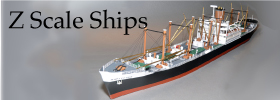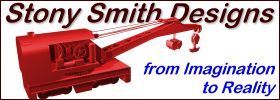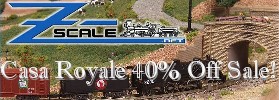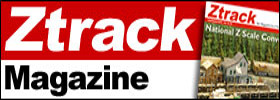- Posts: 34
- Thank you received: 0
Decoder options for Marklins
- seldredg
- Offline
- New Member
-

Scott
ScottE
La Honda, CA
Please Log in or Create an account to join the conversation.
- shamoo737
- Offline
- Premium Member
-

- Posts: 462
- Thank you received: 30
Please Log in or Create an account to join the conversation.
- markm
- Offline
- Senior Member
-

- Posts: 293
- Thank you received: 69
I haven't seen anything on the models you've mentioned. You might want to search the European hobby sites, possibly in German. Also check the European DCC sites like velmo.de/html/english.html
Usually the older Marklin are fitted with a discrete decoder, requiring you to separate the motor power and do mechanical modifications like
www.trainboard.com/grapevine/showthread.php?103675-DCC-decoder-in-M%E4rklin-Pacific-Mikado-steam
Hope this helps,
Mark
Please Log in or Create an account to join the conversation.
- seldredg
- Offline
- New Member
-

- Posts: 34
- Thank you received: 0
Related question: Are simpler decoders used for switches? Using DCC for switches isn't necessary for what I'm doing, but dong one or two would be good as an education.
Velmo has boards for two of the locos I'm interested. Will get more details after I learn German.
ScottE
La Honda, CA
Please Log in or Create an account to join the conversation.
- markm
- Offline
- Senior Member
-

- Posts: 293
- Thank you received: 69
Definitely! Check out the DS series of stationary decoders at Digitrax. BTW you might want to start using the term "turnout" instead of switch. "Switch" has so many so many electrical uses, that it can get confusing at times in posts.
Yeah, the most important thing with DCC is isolating the motor from the track power. You can fry a motor in Z really fast with DCC.
Mark
Please Log in or Create an account to join the conversation.
- seldredg
- Offline
- New Member
-

- Posts: 34
- Thank you received: 0
"stationary decoders" That's the term I needed. My Z ignorance has soared in my absence. Be fun catching up.
ScottE
La Honda, CA
Please Log in or Create an account to join the conversation.
- markm
- Offline
- Senior Member
-

- Posts: 293
- Thank you received: 69
I'll bet the "switches for switches" search drove the search engines crazy!
I've been using double pole, double throw momentary contact, center off toggle or rocker switches: one pole for turnout control and one for turnout indicators. Recently I've started using triple pole switches for the Rokuhan turnouts: two poles to reverse the power and one for indication.
Z scale has just exploded in the past couple of years with at least a dozen new car styles and locomotives. Locos run better than ever, particularly low speed performance and DCC has become cheap and easy. Although, unless you subscribe to Ztrack or frequently haunt sites like this, it's real easy to miss what's going on.
Mark
Please Log in or Create an account to join the conversation.
- shamoo737
- Offline
- Premium Member
-

- Posts: 462
- Thank you received: 30
Please Log in or Create an account to join the conversation.
- seldredg
- Offline
- New Member
-

- Posts: 34
- Thank you received: 0
If you are not going to control switches via DCC, does it matter whether Rokuhan switches are set to power routing or not? Or are switch control and power routing two different questions?
it will be a while before I get a new layout built, but I'm setting up small loop with a siding and spur (?) so I can learn DCC, wiring, etc. and run, test, etc.
ScottE
La Honda, CA
Please Log in or Create an account to join the conversation.
- markm
- Offline
- Senior Member
-

- Posts: 293
- Thank you received: 69
To me there are a lot of complications for power routing or not. The simple answer for DCC is non-routing. But if you want to do occupancy sense, or build for the day when trans ponding decoders are available in Z, you'll want to create isolated blocks and the power routing is a great way to do it.
I'm using them in the power routing configuration, and running feed drops for all three ends. If I ever want the non-routing mode, I just connect all the feeds together.
Shamoo,
Sorry, I spent too many years of engineering pre-multimedia. I have a couple of switches I can shot a picture of to post. I will warn you my camera skill aren't the greatest.
Mark
Please Log in or Create an account to join the conversation.
- seldredg
- Offline
- New Member
-

- Posts: 34
- Thank you received: 0
ScottE
La Honda, CA
Please Log in or Create an account to join the conversation.
- shamoo737
- Offline
- Premium Member
-

- Posts: 462
- Thank you received: 30
Please Log in or Create an account to join the conversation.
- markm
- Offline
- Senior Member
-

- Posts: 293
- Thank you received: 69
Yes, the power routing in the turnout is independent of how you control the turnout. If you're running a DCC loco, its motor is powered from the track indirectly through its decoder. If you have a siding using power routing, when you switch the turnout away from the siding, the loco will just stop. In the non-routing mode, the loco would continue to operate on the siding. So in most cases in DCC, you make all the turnouts non-routing. Power routing is more of an advantage with DC.
But there are times, even in DCC you need to isolate a section of track for a reversing loop or the others I mentioned and the power routing is handy to have.
Shamoo,
Still working on the pictures.
Mark
Please Log in or Create an account to join the conversation.
- shamoo737
- Offline
- Premium Member
-

- Posts: 462
- Thank you received: 30
Please Log in or Create an account to join the conversation.
- garthah
- Offline
- Elite Member
-

- Posts: 502
- Thank you received: 193
The idea of non power routing was a feature of early Z from Marklin because it simplified wiring as only one feed was need to run one train anywhere on your track layout. The power problem in DC is limited to less than 10 vdc and the current is limited that of the draw of the motors in you engine or engines you are running on the head end of your train. So seldom have enough power to burn stuff as quickly as you can in DCC, but it is still possible to smoke stuff.
regards Garth
cheerz Garth
Please Log in or Create an account to join the conversation.
- markm
- Offline
- Senior Member
-

- Posts: 293
- Thank you received: 69
shamoo737 wrote: Mark, I been thinking of ways to turn around the engine without using the hand of god method. I have a turntable, but I don't think that's a realistic way railroads do it unless they are in a big yard, so the Wye is the best solution. Do you have any suggestion on how to do it dcc.
At least on the SP I'm aware of turntables at several locations in N. Cal with the only purpose of turning the engine around at the end of the line or at the end of helper service. So it's at least prototypical.
Electrically I think a wye as just a reversing loop. It seems to me that the frog juicers would work for DCC, one on each of the approach turnouts and possibly one on the wye. I'll have to brush up on my juicer documentation to be sure.
Mark
Please Log in or Create an account to join the conversation.
- seldredg
- Offline
- New Member
-

- Posts: 34
- Thank you received: 0
And is Rokuhan turnout considered to be solenoid 'snap-switch" type turnout?
ScottE
La Honda, CA
Please Log in or Create an account to join the conversation.
- markm
- Offline
- Senior Member
-

- Posts: 293
- Thank you received: 69
The accessory power is routed through the stationary decoder so you can use whatever low voltage power source required by the accessory. No DCC power involved, DCC is just in the tracks.
Yes.
Shamoo,
I slept on your wye question (when I do all my best thinking)
If you're interested, I think I have a DCC way to get the loco to negotiate the wye automatically.
Mark
Please Log in or Create an account to join the conversation.
- seldredg
- Offline
- New Member
-

- Posts: 34
- Thank you received: 0
ScottE
La Honda, CA
Please Log in or Create an account to join the conversation.
- garthah
- Offline
- Elite Member
-

- Posts: 502
- Thank you received: 193
A stationary decoder requires connection to the track power as the decoder has an address so it can be addressed and controlled by your same controller as you control your engine on the DCC layout. I suppose you could have two DCC systems one to control your stationary decoder(s) and one to control your train(s), but I have not seen that sort of usage in the field.
Here is instructions from a digitrax stationary decoder, and is just one of many available. it is not an endorsement of the product as I have not used it with Rokuhan turnouts so do not know what the voltage out to the coil is, but I suspect 12 VDC, Rokuhan only needs reversing 6 VDC.
DS51K1 Installation
1. Turn off track power.
2. Connect the orange and gray wires from the DS51K1 to the turnout motor.
3. Connect the red and black wires from the DS51K1 to the track.
DS51K1 Address Programming
1. Turn off track power and temporarily connect the yellow programming wire from the DS51K1 to the same rail as the black wire.
2. Turn on track power.
3. Using your throttle, select the address you want to program into the DS51K1 and press either c (closed) or t (thrown) to operate the turnout and
program the address.
4. Disconnect the yellow programming wire from the track and fold it away so
that it can’t make contact with the track.
DS51K1 Operation Notes:
DS51K1 is designed to work with turnout machines with SINGLE bipolar coils ONLY. Use of this decoder with other types of turnout machines
will destroy the decoder and will not be covered under warranty.
Please see www.digitrax.com/prd_statdec_ds51k1.php the correct link is for a list of Kato turnouts that are compatible with DS51K1.
cheerz Garth
Please Log in or Create an account to join the conversation.
















